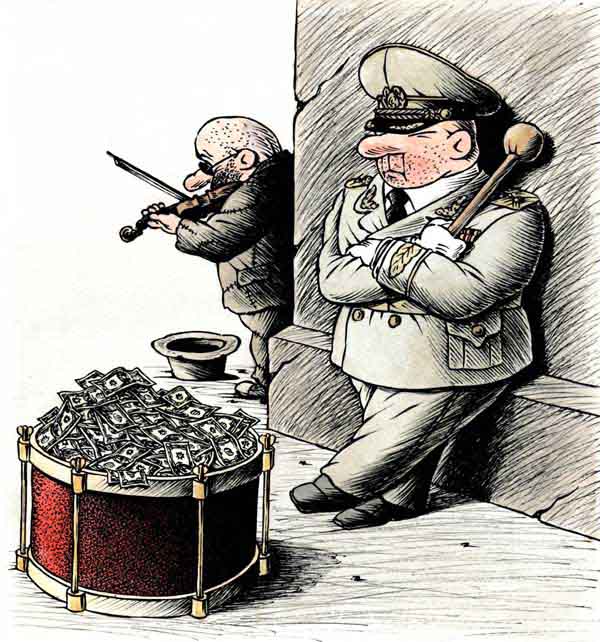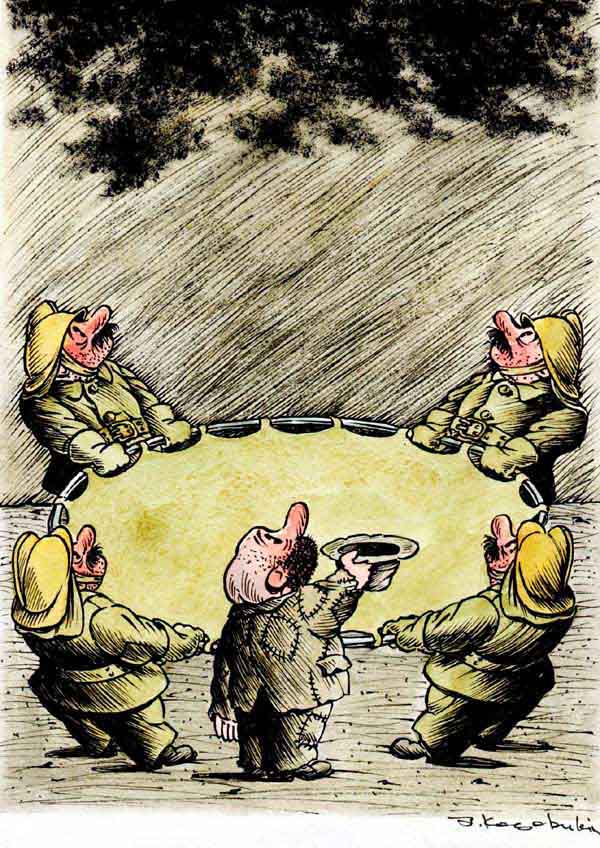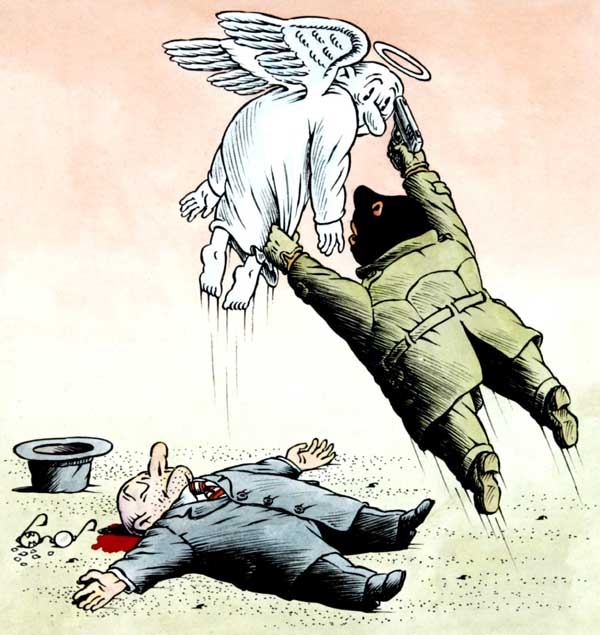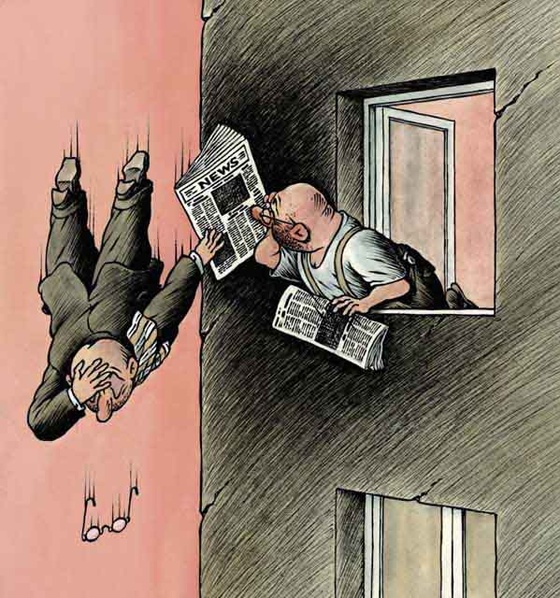Interview with Yuriy Kosoboukin , Russian Cartoonist by Ali Hashemi Shahraki & Behzad Riazi
iranartoon-2009
Translator: Nilufar Arbabi

Why do people recognize Kosoboukin as a cartoonist not as an Aerospace Engineer
?
My father was an army officer. I was born in Iman, a city in Russia near Japan and then we went to Voklograde, a city near Moscow. I studied aerospace engineering in Kharkov and I went to Kiev for work.
Now I and my family live in different countries. I mean after seperation of Great Russia, I lived in Ukraine. When I was studying aerospace engineering, they were making an aeroplane by the name of Antonof. It was the name of the project’s responsible. We worked for 3 years on this project, at that time I worked on its design and after 3 years I left my worked and started to work on drawing cartoon. When I worked in aeroplane I was a creator and I think that cartoon is a kind of creation too, although in both cases my mind put the elements together and makes something.
How do you acquaint with cartoon, and which cartoonist influenced you more?
I was fond of works of some Russian and European cartoonists but Oleg Tesler, Sergei Tunin and Zelatkovsky influenced me more, and I’ve learnt many things from them and little by little I created my own style. I saw their works in different magazines and newspapers.
Cartoon characters of each one of these three Russian cartoonists were really different from each other and I selected thing from them in my mind. For example Zelatkovsky’s philosophy and strong satire of Tesler. Each one of my cartoons is in fact a story that starts from one place and ends in another place. It says what it was and what it will be in future.
Oleg Tesler influenced me more, because he makes comic strips and tells a story in different parts.
I saw these works but I mixed different frames in one frame. I love to mix different stories together. I was lucky to be acquainted with these artists and we worked together as a group,
Oleg Gutsol that worked for a famous magazine once told me: “Yuriy , why do you insist on mixing all phases in one frame? You can make them more and earn more money?” I answered:” I work in reverse.”

Where do you find the project of your works?
I don’t know. I walk in the streets and the projects come themselves.
Abstracting a story in one frame that must be in many frames is a hard work and many cartoonists can’t do it, and also transfering meaning in one frame is very hard, although its influence on the viewer is more.
Did you worked so simply from the beginning?
A Russian proverb says:” We love to do the hardest works.”

Did you studied literature and read stories for reaching to this stage?
Yes, I read books a as cartoonist, especially classic stories and I love works of famous writers such as Gogol and O Henry.
So you must be read War and Peace as a Russian Cartoonist?
Yes, and I recommend reading it to all cartoonists that want to draw cartoons about war and peace.
Characters are known by their behaviours, talkings and their cloth wearing. Characters of your works are all dramatized. They are all the same but each one transfers a special feeling to the viewer. For example a yogi is a real yogi, a general is a real general and a servant is a real servant. How did you get in to this place?
As I said I go to the streets and I choose my cartoon characters from ordinary people. I’ve made many characters by this style. When I see a person doing something I ask myself did I make such a character in my cartoons or no? for example I had many homeless characters in my cartoons, but the first time that I wanted to draw a homeless character I couldn’t ,because I had home, job and income, so I couldn’t understand them. I went out and I found a homeless person and I talked to him. I saw that he is very upset and he doesn’t like to have relation with people and he is in a great stree. By more association to these people I could create such characters better.
For this reason wherever I go I pay attention to people and their works and what I draw on the paper is my feelings. For example after graduating from university I went to army and I worked there for 3 years. The generals and soldiers of my cartoons are from that time. I left army because I didn’t like to be a general and people laugh at me. My favourite characters are ordinary people and I feel close to them.

A rich character also exists in your cartoons. Is this character created naturally or because of communist government?
This character is symbol of selfish people. I don’t want to confront with capitalism or policy in my cartoons. Such people always existed, before Russia and after Russia, even in Stone Age. These people want everything for themselves, but in fact they have nothing.
By attention to projects of your works, what’s the place of Omanism or Humanistic subjects in your works?
Omanism was a new artistic movement that was created before cartoon’s prevalence in this new shape. Cartoon has been influenced a lot from this movement, in fact there are some cartoons that are just for laughing and some are about social problems and ordinary people. I love such people and I feel close to them. I’m so happy that you found Omanism inspirations in my works. I believe in a movement about people’s kindness to each other and I love this movement influences all people around the world. I try to help for this movement.
As you said your artworks are not just satire or humour, they have philosophy and deep meaning. On the other hand it seems that the humour of your works belongs to the middle class society, can you explain?
I don’t have negative look in my artworks even in works with low humour. Any way, it’s a kind of humour like other black humours. I want to show a humour that everybody understand it. Like a poem that illiterate people understand it less and literate people understand it more.
At a glance to your works we can observe that you’re worked in different times in various projects, for example you have lots of cartoons with the subjects of hat or homeless people. And also with the subject of cookers, clothe washers, prisoners and yogis. These characters became symbols in your works. Are these symbolic characters made of hard working or you created them by the aim of symbolism from the beginning?
All cartoonists in their life time try to draw cartoons about whatever they see. I worked with the characters that I could, on the other hand I tried to create characters that are symbol of a social class, not a single person. I drew the general, the cook and his hen and the people with long hat at the same time. My characters don’t have special time. I created them simultaneously. Perhapse the reason for what you say is that you couldn’t follow my works by time.
Usually cartoonists create their create their works by the subject of his society; my works are from my society that became collections in time. These collections became more by time passing and I think nobody has seen all of them. I’m sure you haven’t seen my collection of snowmen, but they are very famous in my country, or my cartoons abour war. Fortunately I’ve never been in a war, but my father was wounded in war. He eas thirty one years old in World War two. Both my grand fathers died in war and I was influenced by these events. I draw lots of cartoons about these subjects. For example at the time of poverty and starvation I drew lots of cartoons about them.

Describe more about snowmen collection?
I named my snowmen collection “Ice Age”. In my opinion snowman is the symbol of contmporary people. The snowman has soul that when it melts the soul comes out of its body. Like a human that borns and dies. Most snowmen cartoons are tragic, because somebody makes it and become happy, and then he let him alone. In my opinion it’s a big tragedy.
How many cartoons have you drawn? Do you still draw cartoons? I’ve seen many old cartoons that you participated in festivals have been published before, why?
I’ve never counted my cartoons, but I think it’s about thirty thousand cartoons. It’s true that I use many of my old cartoons, but I have ideas that I haven’t drawn yet. I draw about 20 cartoons each month, but I can’t mention them pure cartoon. I still work.
Any way thank you for your attention to my artworks.



Comments